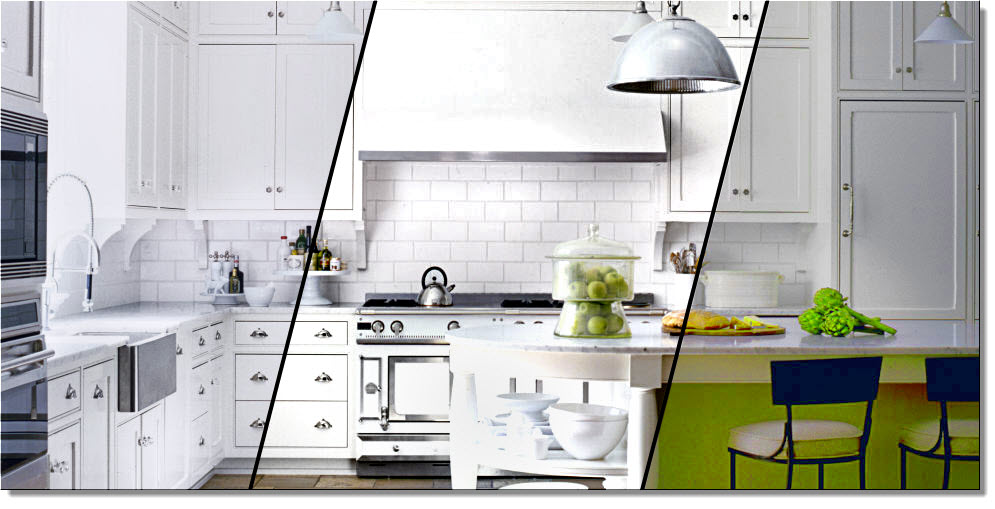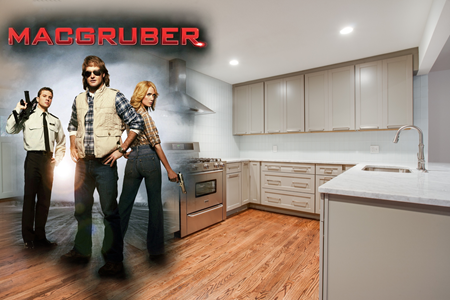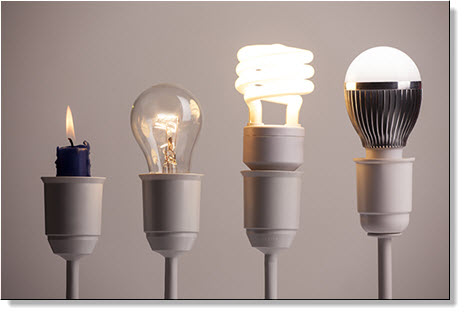Kitchen Design and Remodeling
Kitchen Lighting
Color Is How You Light It

If you have embarked on a kitchen remodel, it’s most likely not just a passing fancy but an endeavor that has been years in the making. You’ve done your research, interviewed designers, and you may have even looked at hundreds, if not thousands, of photos of beautiful kitchens. Here’s something you may not have considered … How will you work color and lighting into your kitchen design?
As a savvy homeowner, you realize that color plays a major role in the look and feel of a kitchen. However, lighting is just as important a consideration when designing your dream kitchen. Well thought out lighting can make your kitchen look outstanding, whereas, improper lighting could cause untold headaches. When you mix color and light, you are actually mixing two colors together. Different types of light have different color temperatures that can play a crucial role in the perception of the colors you have selected for your kitchen design project.
So before you make those final selections, consider a design dilemma once encountered at Kitchen and Bath Creations.
A Kitchen Lighting Design Story
Once upon a time in the magical world of kitchen design, one of our treasured clients is basking in the glory of her newly designed dream kitchen—crisp, clean lines, bright white cabinets, complete with beautiful crown molding.
 However, as she gazes up to the ceiling, she notices something is not quite right. Alas, her beautiful crown molding is not perfectly white, definitely not the “bright white” she ordered. “Oh No!” she exclaims. “This is not right; I asked for white; and this must be fixed TONIGHT!”
However, as she gazes up to the ceiling, she notices something is not quite right. Alas, her beautiful crown molding is not perfectly white, definitely not the “bright white” she ordered. “Oh No!” she exclaims. “This is not right; I asked for white; and this must be fixed TONIGHT!”
Our now disenchanted homeowner hurries over to her carefully planned phone charging station and immediately gets Jeff Myers on the line. Now Jeff is no super hero, but he has watched all episodes of MacGruber, so he was the perfect person to become involved. As Jeff speaks with the client, she explains (in a tone of total dismay) that her beautiful “bright white” crown molding and even the kitchen cabinets were not so white after all. Ready to make everything right – Jeff gets his keys and drives to the home. After visiting the home, Jeff decides to re-order the crown molding. Problem solved!
Unfortunately, this did not bring about the happy ending we had hoped for. Neither the original or the replacements were quite right; they just weren’t “bright white.” Was it a trick . . . was it an illusion? Had a spell been cast upon the kitchen?
Now as perplexing as this was, we knew there had to be a solution. So we enlisted the help of our super-hero cabinet manufacturer representative who also visited the home and met with the disenchanted homeowner. Prepared for the challenge, he brought several white wood blocks with him and demonstrated to the homeowner how, when the blocks were held up to the doors, they matched perfectly; however, when those same white wood blocks were held up to the crown molding at the ceiling, they no longer ‘matched’ the doors. This drove home the point that “yellow” lighting can sometimes create the illusion that the “wrong” color (in this case the molding) has been installed. Armed with this helpful information, KBC worked with the client to ensure complete satisfaction and help select kitchen light bulbs that made everything look proper…
…And they all lived happily ever after.
In this particular kitchen remodel, the “perceived” variation in paint color was resolved by changing the light bulbs. In so doing, the color temperature of the kitchen lighting was changed. This experience prompted some research on the subject of how differing light sources affect color.
 The fact is color never stands alone. Any kind of light—daylight, artificial light, even candlelight—can dramatically change the way a certain color appears. “Color is light made visible, and the atmosphere of the air we breathe, and the quality of the light passing through it affect how we see color” says David Kaufman in his book “Color and Light: Luminous Atmospheres for Painted Rooms”. In other words, color is how you light it.
The fact is color never stands alone. Any kind of light—daylight, artificial light, even candlelight—can dramatically change the way a certain color appears. “Color is light made visible, and the atmosphere of the air we breathe, and the quality of the light passing through it affect how we see color” says David Kaufman in his book “Color and Light: Luminous Atmospheres for Painted Rooms”. In other words, color is how you light it.
We love it when homeowners are inspired to “mix up” their kitchen color palette. If you are thinking of a new kitchen, then feel confident to consider bold and different colors. Our experienced kitchen designers know just how to use the color and temperature attributes of artificial lighting to purposefully modify color. In turn, you are able to cleverly specify lighting that will allow your chosen color to remain true and just the way you want it!
With all the new technology on the market that affects how a room is lit, KBC has put together a few facts and tips that can help you arrive at the perfect color.
Kitchen Lighting and Design
Kitchen Design – Artificial Light Sources
- Incandescent Bulbs: These generate yellow light that intensifies warm colors but tends to dull cooler colors.
- Halogen Bulbs: These newer incandescent bulbs produce brighter, white light that is more like sunlight.
- Fluorescent Bulbs: These generate cool, blue light that amplifies blues and greens, but mutes warmer colors.
“Soft white” Fluorescent Bulbs: These mimic the warmth of incandescent bulbs, but all colors can appear faded in their light. - Full-spectrum fluorescents: Although expensive, these bulbs produce light that most closely resembles natural sunlight.
Artificial Light Fixtures
- Sconces: These fixtures give off indirect lighting by aiming the light toward ceilings or walls.
- Shades: Lampshades will change the coloration and strength of the bulb inside them. If the lampshade is of a warm hue, it will cast this glow onto the other colors in the room. Strongly colored shades will mute any surrounding colors, while white or ivory shades will give off the brightest light.
- Parabolic Lights or Down Lights: They direct light straight down from the ceiling. This provides a lot of light on work surfaces and floors, but can cause ceilings and the top edges of walls to appear dark in comparison.
Color Perceptions and Feelings
- Red: Dynamic, exciting and stimulating.
- Orange: Mellower than red, yet still stimulating and warm; friendly.
- Yellow: Cheerful, radiant, happy, uplifting.
- Green: Relaxing, refreshing, tranquil.
- Blue: Calming, comforting, cooling, peaceful.
- Violet: Dignified, rich, noble, intense.
- Cool Colors: Greens, blues, and violets—tend to recede and make rooms appear larger and spacious.
- Warm Colors: Yellows, reds, and oranges—seem to advance and make a room feel smaller and more intimate.
When to go White in Your Kitchen
- To complement, rather than compete with, nature’s palette, make the most of a room with a striking outdoor view. “A white room picks up all of the color coming in from outside” – Andrew Flesher, named one of House Beautiful Magazines “Next Wave of Designers”
- To create a feeling of intimacy use wood paneling to generate artificial warmth as it absorbs natural light. Use white walls to reflect daylight directly, imbuing the interior with a cozy glow.
- To reclaim the visual possibilities of a period space, Andrew Oyen, an associate at the New York City architecture and design firm Ferguson & Shamamian, remembers clients who were moving into an old apartment painted in lavish, almost overwhelming colors. He recalls . . . “They whitewashed the whole apartment, which created a sense of neutrality. Then they gradually brought back color over time. Going white first enabled them to see the space in a new way.”
- To show off beautiful moldings use white as it showcases the details. “It becomes about the play of shadows” – Andrew Flesher
We love it when they all “live happily ever after,” and we will do all that is necessary to help you achieve the kitchens of your dreams. So the next time you’re dreaming of your kitchen remodel, give KBC a call at 410.772.3240. We know a great kitchen doesn’t just happen, it’s a creation.
